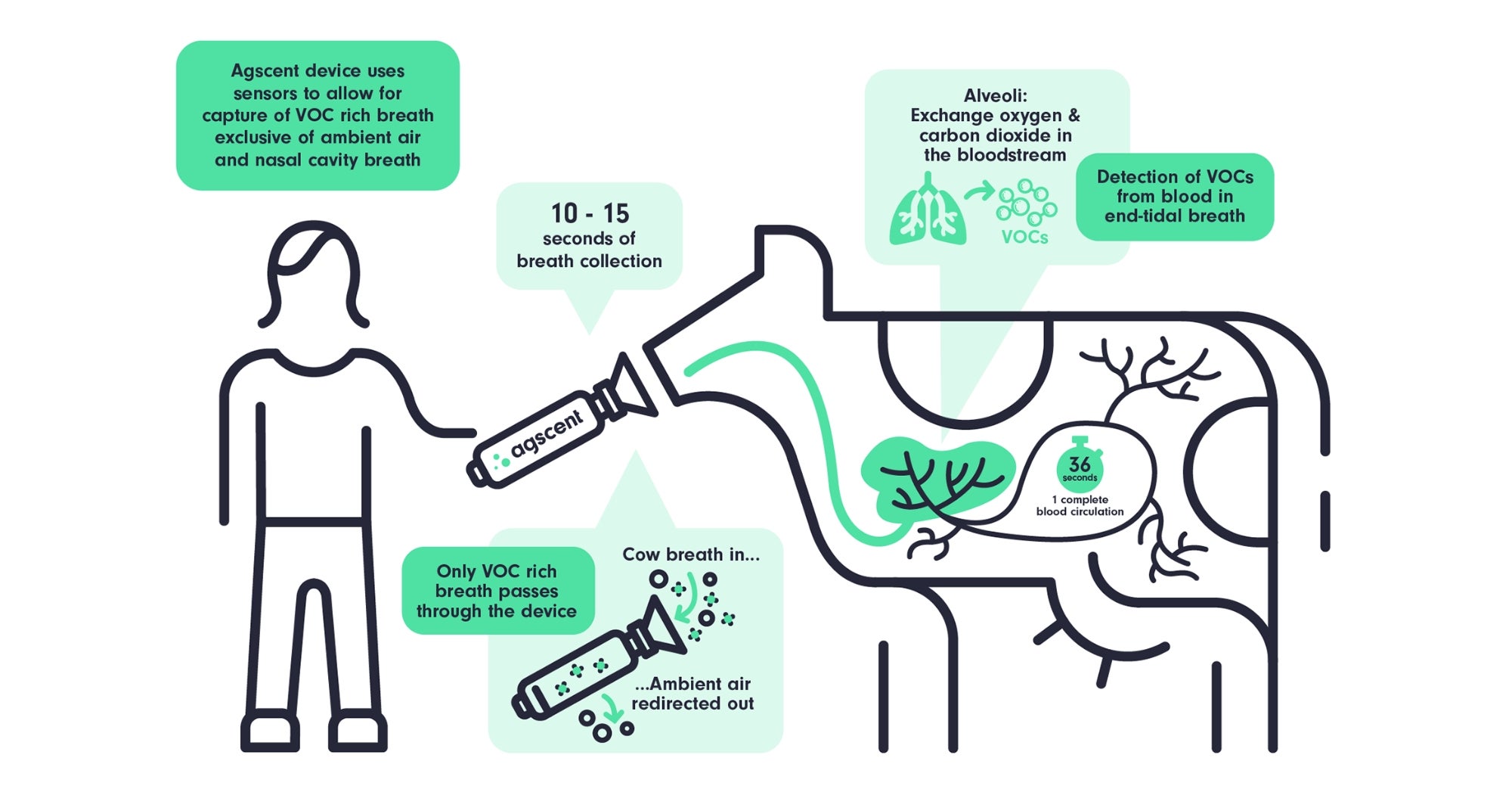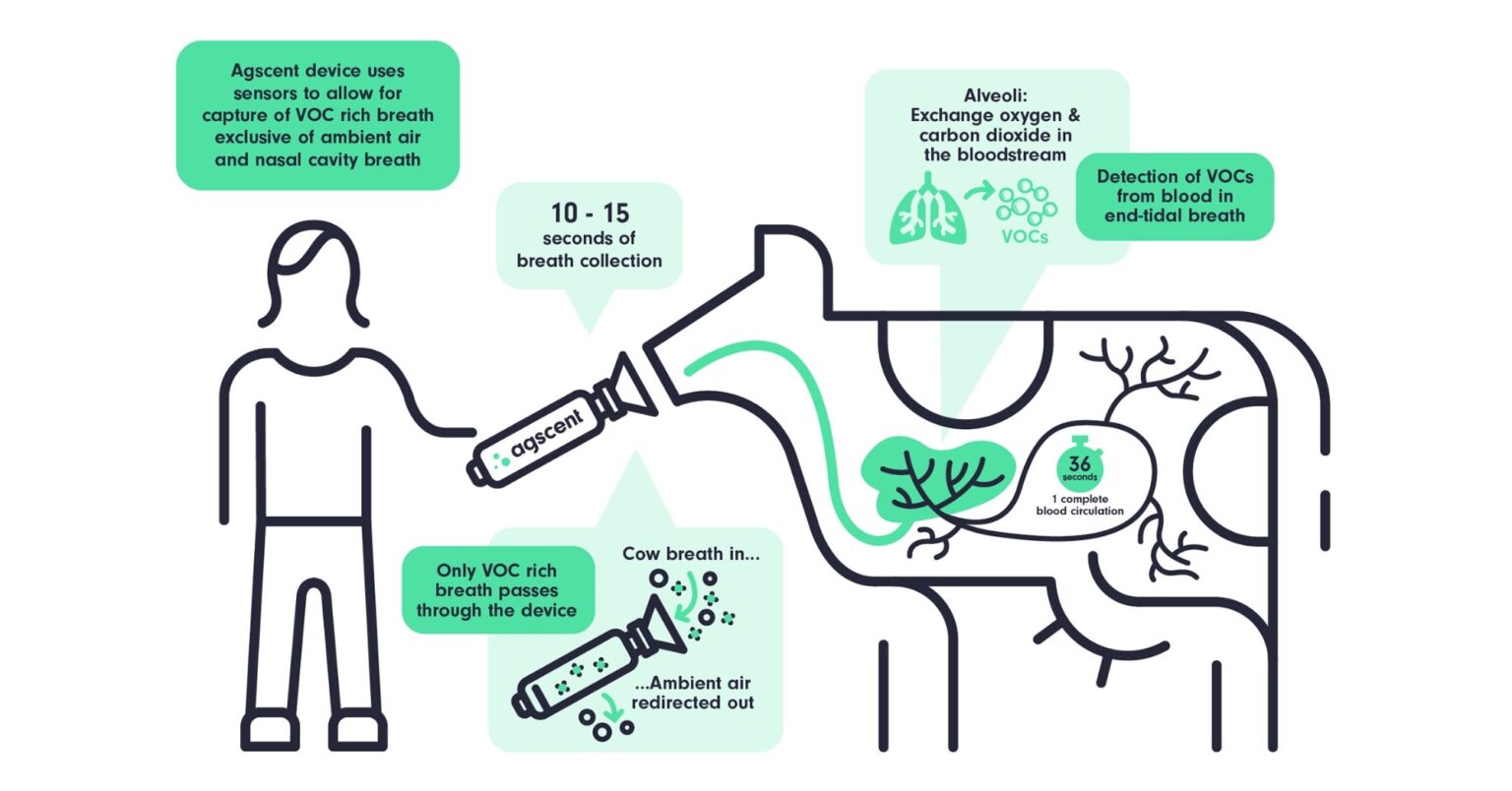An Australian bio-agritech company is taking a different angle on managing herd health, reproduction, and sustainability … through measuring cow’s breaths. Using nano-sensors originally developed through NASA programs, Ascent is analyzing cow’s breaths to diagnose pregnancy in cattle in real time.
“Every breath tells a story,” the company says, and its technology is designed to make those stories measurable and actionable for producers.
The Agscent Breath device, with its $10,000 price tag, enables farmers to detect pregnancy in cows from as early as day 16 to 18 post-insemination by analyzing volatile organic compounds in the animal’s breath. “We have developed a method of breath collection and analysis to identify specific volatile organic compounds in breath which are able to distinguish pregnant (wet) cows from not pregnant (dry) cows from day 16 post insemination,” Agscent explains.
This represents a major shift from traditional pregnancy testing methods such as rectal palpation or ultrasound, which require veterinary involvement and pose risks to both animal and handler. “Removing the risk of a shoulder injury or being kicked when doing a rectal test, Agscent’s new technology, the Breath, will revolutionize cattle management in the Meat, Livestock & Dairy industries,” the company states.

Agscent emphasizes that the device is non-invasive, efficient, cost-effective, and highly accurate. Farmers can use it themselves on-site without waiting for a vet, allowing them to carry out pregnancy testing “when it suits them, in a safe and accurate manner.” According to the company, the result is “increased productivity gains and improved animal welfare.”
The innovation is part of a growing scientific field known as breathomics, which is increasingly applied in human medicine to detect disease. Agscent is adapting those lessons to livestock. “At Agscent, we are applying the lessons of human medicine to breath diagnosis principally for livestock and farming animals,” the company notes.
A 2022 study published in Veterinary Sciences tested an electronic-nose prototype using direct perineal odor sampling and reported clear discrimination between estrus and non-estrus phases in a trial of 35 Holstein cows.
While that study sampled perineal headspace rather than exhaled breath and was relatively small, its results support the broader feasibility of using volatile organic compound signatures for non-invasive reproductive monitoring.
The technology is also being used in methane and emissions monitoring. Agscent Air is a methane and carbon dioxide monitoring device that gives producers real-time data on emissions from individual animals or herds.
By quantifying methane emissions, producers gain insights into feed efficiency, genetics, and overall herd health. Methane output is tied to digestion and nutrient utilization, meaning high emitters are often less efficient animals. “Monitoring methane emissions provides valuable insights into the health and wellbeing of livestock,” Agscent says. “By identifying high methane emitters, farmers can implement management practices that improve animal health and productivity.”
Agscent’s devices have undergone validation trials with institutions including the University of Sydney, Cornell University, and CSIRO, which confirmed strong correlations between Agscent systems and established measurement tools such as respiration chambers and GreenFeed. These validation efforts lend credibility to the technology for applications ranging from selective breeding for lower-emission animals to feed-additive verification and carbon market participation.
The technology is also being used in breeding programs to select lower-emitting animals, making emissions reductions both permanent and cumulative. Verification-grade emissions data can also support participation in carbon markets, sustainability-linked supply chains, and independent validation of feed additive claims. “Forward-thinking producers with verified low-emission credentials can differentiate their products in increasingly environmentally conscious markets,” the company says.
Founded on a farm in regional New South Wales, Agscent describes itself as a company built by producers for producers. “We know the value of optimizing reproduction because we live it every day — we have primary production in our blood,” its team notes.
“Imagine if anyone could breathalyze a cow and identify pregnancy or disease-related biomarkers using nano-sensors in a way that is easy to use, non-invasive, efficient, accurate, early, affordable, and at the point of care.”


